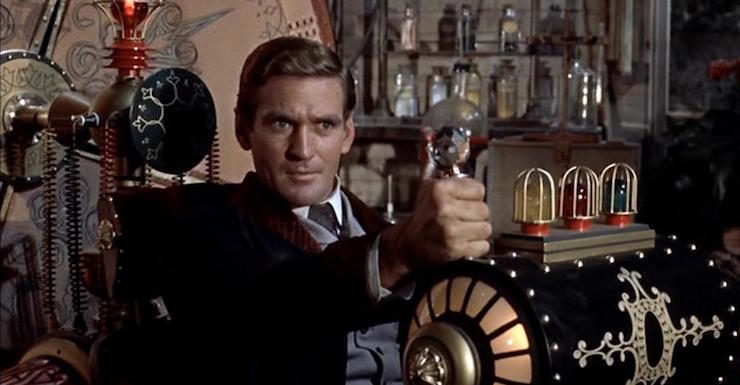Time travel in sci-fi literature tends to be approached in two fundamentally different ways, and these two ways correspond to whether time is seen as objective or subjective. The brute force approach, as I’ll call it, ties in with our common sense intuition that time is an objective feature of reality, that it would keep ticking away regardless of whether or not anyone was there to measure it. In this approach, a machine or device is created (or discovered) that somehow allows its user to travel through time in a non-standard way. The mind travel approach, on the other hand, comports with Einsteinian and Kantian considerations about the mind-dependence of time; in it, travelling into the past is shown to be possible through a sort of rigorous mental training or discipline, with no recourse to technology required.
Personally I find the mind travel approach more compelling, but here I want to touch on and recommend two novels from each camp—and one curious outlier.
The Time Machine
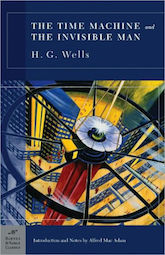 The Time Machine by H.G. Wells is the ur-time travel novel; first published in 1895, it is (of course) where the term “time machine” originated, and is probably the strongest exemplar of the brute force approach. In it, an unnamed English scientist (simply called “the time traveller”) builds a machine that carries him over 800,000 years into the future—there he finds that humanity has split into two species: the effete, feckless, surface-dwelling eloi, and the vicious, light-shunning morlocks who feed on them. Filled with ruminations about the fate of civilization and the earth itself, and the long-term ramifications of class division, this book remains a thought-provoking and ultimately moving (and quick!) read.
The Time Machine by H.G. Wells is the ur-time travel novel; first published in 1895, it is (of course) where the term “time machine” originated, and is probably the strongest exemplar of the brute force approach. In it, an unnamed English scientist (simply called “the time traveller”) builds a machine that carries him over 800,000 years into the future—there he finds that humanity has split into two species: the effete, feckless, surface-dwelling eloi, and the vicious, light-shunning morlocks who feed on them. Filled with ruminations about the fate of civilization and the earth itself, and the long-term ramifications of class division, this book remains a thought-provoking and ultimately moving (and quick!) read.
11/22/63
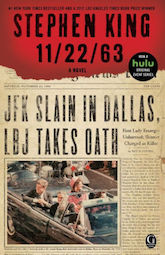 11/22/63 by Stephen King is a more recent (2011) time travel story, one of the strongest in decades. In it, Jake Epping, an English teacher, uses a time portal to travel back to 1958 (the only year the portal opens onto), in an attempt to prevent the assassination of John Kennedy. The time portal is a naturally-occurring phenomenon (likened at one point to a bubble floating in ginger ale)—there’s no question of the user having to do anything but step into it; this tale is very much in the brute force camp. King’s initial description of Epping’s experience of 1958 is one of the most evocative pieces of writing I know of—you are transported, via King’s prose, as surely as Epping is. But King’s ultimate slap-down of the “everything would be fine if only JFK had lived” school of thought is what makes the book significant, and deeply haunting.
11/22/63 by Stephen King is a more recent (2011) time travel story, one of the strongest in decades. In it, Jake Epping, an English teacher, uses a time portal to travel back to 1958 (the only year the portal opens onto), in an attempt to prevent the assassination of John Kennedy. The time portal is a naturally-occurring phenomenon (likened at one point to a bubble floating in ginger ale)—there’s no question of the user having to do anything but step into it; this tale is very much in the brute force camp. King’s initial description of Epping’s experience of 1958 is one of the most evocative pieces of writing I know of—you are transported, via King’s prose, as surely as Epping is. But King’s ultimate slap-down of the “everything would be fine if only JFK had lived” school of thought is what makes the book significant, and deeply haunting.
Time and Again
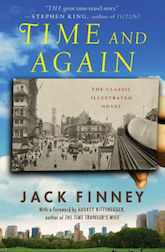 Time and Again (and its 1995 sequel From Time to Time) by Jack Finney (1970), was hailed as “THE great time-travel story” by Stephen King in the afterword to 11/22/63. It is the greatest exemplar of the mind-travel approach to time travel. Simon Morley, an illustrator in New York City in 1970, is recruited by government agents to participate in The Project—an experimental scheme to send people back in time through what amounts to self-hypnosis. The idea is: immerse yourself in the thinking of a period, don the dress, beliefs and attitudes of the period, and do these things in a place that has remained the same since that period, and—you will literally be there, and then. The Dakota apartment building overlooking Central Park is the “time machine” of the story—i.e., it’s the unaltered bit of New York architecture that allows Morley to convince himself that he’s in 1882, and thus to successfully appear there. It sounds crazy, but Finney’s meticulous description of the workings of The Project—and his beautifully evocative conjuring of New York in 1882—doesn’t just suspend disbelief; it annihilates it. An enthralling, amiable, and astonishingly researched classic.
Time and Again (and its 1995 sequel From Time to Time) by Jack Finney (1970), was hailed as “THE great time-travel story” by Stephen King in the afterword to 11/22/63. It is the greatest exemplar of the mind-travel approach to time travel. Simon Morley, an illustrator in New York City in 1970, is recruited by government agents to participate in The Project—an experimental scheme to send people back in time through what amounts to self-hypnosis. The idea is: immerse yourself in the thinking of a period, don the dress, beliefs and attitudes of the period, and do these things in a place that has remained the same since that period, and—you will literally be there, and then. The Dakota apartment building overlooking Central Park is the “time machine” of the story—i.e., it’s the unaltered bit of New York architecture that allows Morley to convince himself that he’s in 1882, and thus to successfully appear there. It sounds crazy, but Finney’s meticulous description of the workings of The Project—and his beautifully evocative conjuring of New York in 1882—doesn’t just suspend disbelief; it annihilates it. An enthralling, amiable, and astonishingly researched classic.
Bid Time Return
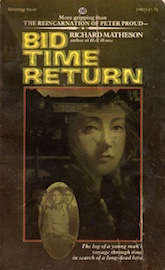 Bid Time Return (1975) by Richard Matheson was made into the pretty good but somewhat syrupy movie Somewhere in Time (1980) starring Christopher Reeve, and subsequent editions of the novel bore that title. It is also very much in the mind-travel camp. In it, Richard Collier, a ’70s-era screenwriter with terminal brain cancer, decides to spend his dying days at an old California resort; once there, he becomes obsessed with a portrait of a 19th century actress who frequented the same hotel. Using a method very much akin to that described in Time and Again, he travels back to 1896, and meets and falls in love with the actress, notwithstanding difficulties created by her over-protective manager. It’s a beautifully written, heartfelt story of a love so powerful that time itself can’t impede it, but part of what makes it a standout for me is its fundamental ambiguity. The story is presented mostly in the form of Collier’s journal entries—what’s unclear is whether the events as depicted are really happening, or a fantasy being spun by a cancer-riddled, deteriorating brain. Matheson himself remains non-committal on this question, right to the last page—no mean feat!
Bid Time Return (1975) by Richard Matheson was made into the pretty good but somewhat syrupy movie Somewhere in Time (1980) starring Christopher Reeve, and subsequent editions of the novel bore that title. It is also very much in the mind-travel camp. In it, Richard Collier, a ’70s-era screenwriter with terminal brain cancer, decides to spend his dying days at an old California resort; once there, he becomes obsessed with a portrait of a 19th century actress who frequented the same hotel. Using a method very much akin to that described in Time and Again, he travels back to 1896, and meets and falls in love with the actress, notwithstanding difficulties created by her over-protective manager. It’s a beautifully written, heartfelt story of a love so powerful that time itself can’t impede it, but part of what makes it a standout for me is its fundamental ambiguity. The story is presented mostly in the form of Collier’s journal entries—what’s unclear is whether the events as depicted are really happening, or a fantasy being spun by a cancer-riddled, deteriorating brain. Matheson himself remains non-committal on this question, right to the last page—no mean feat!
Kindred
 Kindred (1979) by Octavia E. Butler is the outlier. It is often classified as science fiction simply because it is a time-travel story; probably it is best thought of as time-travel fantasy (Mark Twain’s A Connecticut Yankee in King Arthur’s Court would be another example of this). A young African-American woman named Dana Franklin is a writer living in present-day Los Angeles. One day she suddenly feels strange, swoons, and finds herself transported back to a plantation in antebellum Maryland, where she has to live as a slave—until she just as suddenly jumps back to the present and normality. Her life becomes a nightmare as these time-shifting leaps continue to happen—she never knows when they are going to happen, or for how long she’ll be trapped in this particularly hellish past. At one point her white husband, Kevin, goes back with her—he becomes trapped in the past for five years. The question of how the time leaps are being accomplished (are they somehow being caused by Dana’s mind? Are they a natural phenomenon? Has Dana been chosen for some inscrutable reason?) is never addressed—and it really doesn’t matter; that’s not what the book is about. What the book is about (among other things) is the hideousness of slavery—how it blighted the lives of the slaves, of course, but also the ruinous and degrading effect it had on the slaveholders. It remains an enthralling, disturbing modern classic.
Kindred (1979) by Octavia E. Butler is the outlier. It is often classified as science fiction simply because it is a time-travel story; probably it is best thought of as time-travel fantasy (Mark Twain’s A Connecticut Yankee in King Arthur’s Court would be another example of this). A young African-American woman named Dana Franklin is a writer living in present-day Los Angeles. One day she suddenly feels strange, swoons, and finds herself transported back to a plantation in antebellum Maryland, where she has to live as a slave—until she just as suddenly jumps back to the present and normality. Her life becomes a nightmare as these time-shifting leaps continue to happen—she never knows when they are going to happen, or for how long she’ll be trapped in this particularly hellish past. At one point her white husband, Kevin, goes back with her—he becomes trapped in the past for five years. The question of how the time leaps are being accomplished (are they somehow being caused by Dana’s mind? Are they a natural phenomenon? Has Dana been chosen for some inscrutable reason?) is never addressed—and it really doesn’t matter; that’s not what the book is about. What the book is about (among other things) is the hideousness of slavery—how it blighted the lives of the slaves, of course, but also the ruinous and degrading effect it had on the slaveholders. It remains an enthralling, disturbing modern classic.
 Prentis Rollins has over twenty years of experience working as a writer and artist in the comics industry. His previous titles include How to Draw Sci-fi Utopias and Dystopias, The Making of a Graphic Novel, and Survival Machine (Stories). He has also worked for DC Comics between 1993—2013 for titles such as Batman, Superman, Green Lantern, JLA, and dozens more. The Furnace is his debut full-length graphic novel. He lives in London with his wife and three children.
Prentis Rollins has over twenty years of experience working as a writer and artist in the comics industry. His previous titles include How to Draw Sci-fi Utopias and Dystopias, The Making of a Graphic Novel, and Survival Machine (Stories). He has also worked for DC Comics between 1993—2013 for titles such as Batman, Superman, Green Lantern, JLA, and dozens more. The Furnace is his debut full-length graphic novel. He lives in London with his wife and three children.










